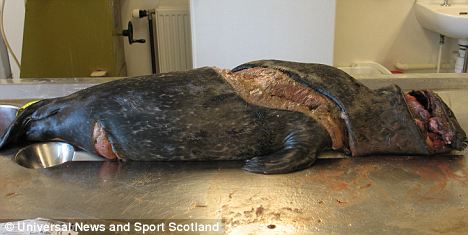Bearing distinctive and horrific wounds, the seals have now been found on beaches in Fife, as well as in Norfolk, in the past year.

The injuries are so severe that marine biologists say the seals look as if they had been put through a giant pencil sharpener.
Now a team of scientists has launched an urgent investigation into the seal deaths in an effort to find out what is causing them.
Unless the experts work out the cause of these 38 bizarre deaths, it is feared more seals will suffer the same fate.
Dr Dave Thompson, seal biologist at the Sea Mammal Research Unit at St Andrews University, is leading the investigation.
Seals with similar injuries have also been found on beaches in Canada over the last decade.
'These are catastrophic, gruesome injuries,' he said. 'At this stage we don't know for sure what's causing it. It's a mystery we need to sort out.'
The injuries appear to be caused by a bladed device. Scientists have ruled out military craft, fishing nets and boat propellers.
All the carcasses display one long, smooth cut that spirals around the head and body. It is thought the seal would have to have been rotated against a giant blade to receive the wound.
In some cases seals have been stripped to the bone.

Dr Thompson added: 'The seals died quickly from their wounds. It looks as they were drawn or pushed past some sort of mechanical device, which caused deep tissue injury. The skin and blubber layer has been reamed off. A spiral flap of flesh has come off all the animals. Although some seals were killed by a skull injury, there are no other bone injuries or deep wounds.
'We can suggest what kind of machinery might do this damage but can't yet specify what it is.'
This year a total of 18 common and grey seals have been found with these injuries in St Andrews Bay and in the Firth of Forth.
In Norfolk, 20 cases have been reported over the past year, with six during July. A handful of seal deaths go back to 2008.
Other have been found in Canada.
The fact that the carcasses have been found in areas so far apart from each other has baffled scientists and there are several working theories to explain the deaths.
A website blogger in Norfolk suggested that tidal turbines may have killed the seals but as there are no turbines near the site of the grim discoveries in Scotland, this theory has been scrapped.
The leading theory is that the seals have ended up in some kind of engine. The lacerations cannot have been inflicted by a traditional propeller which causes a distinctive 'chop' wound.
Scientists now think the seals must have been rotated against a blade inside some kind of cowling or a duct.
Many sea vessels now use propellers known as bow thrusters, which some people have thought may have caused the injuries. However, research into this explanation is inconclusive as many more carcasses would be washing ashore around the world if this were the case.
Scientists are trying to work out whether similar machinery is located in the waters off Norfolk and St Andrews, as well as the Canadian site.
At the moment, all scientists can do is try to rule out theories in the hope of solving the mystery.
Richard Lochhead, Scotland's Environment Secretary, said: 'Seals form an important part of Scotland's rich marine environment and it's critical we establish the cause of these deaths and do all we can to protect our seal populations, particularly as numbers have reduced in recent years.
'I would encourage any member of the public who encounters a carcase to call the Sea Mammal Research Unit.'
The numbers of common and grey seals are in decline in the Northern Isles, Firth of Tay and off the Argyll coast.
Dr John Baxter, head of species management with Scottish Natural Heritage, said: 'With the significant decline in numbers of common or harbour seals on the east coast and in the Northern Isles of Scotland in recent years it is important that the cause of these injuries and the scale of the problem are identified as soon as possible.'



The cuts on the seal are spiral in nature as if it has passed through the centre of cutting blades? There is a system under design that is called a "Rim Driven Propulser" and the word "propulsar" is correct not a "propeller" before pedantic souls start trying to correct me. If you can imagine a rim like a wheel with the blades pointing inwards and a hollow space in the centre no hub, this design is possibly more efficient with less cavitation effect on the blades e.g. less noise. I would think it feasible for certain navy's to be testing this system on submarines or surface vessels hence no one owning up to the mysterious seal deaths please see the following link for an article about "Rim Driven Propulsers"